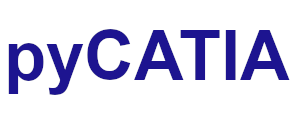pycatia.smt_interfaces.dmo_thicknesses¶
Module initially auto generated using V5Automation files from CATIA V5 R28 on 2020-09-25 14:34:21.593357
Warning
The notes denoted “CAA V5 Visual Basic Help” are to be used as reference only. They are there as a guide as to how the visual basic / catscript functions work and thus help debugging in pycatia.
- class pycatia.smt_interfaces.dmo_thicknesses.DMOThicknesses(com_object)¶
Note
CAA V5 Visual Basic Help (2020-09-25 14:34:21.593357)
System.IUnknownSystem.IDispatchSystem.CATBaseUnknownSystem.CATBaseDispatchSystem.CollectionDMOThicknessesInterface to access a CATIADMOThicknesses and computeThicknesses- add(i_product_to_thickness: Product, i_thickness1: float, i_thickness2: float, i_use_constraints: int, i_constraints: tuple, i_shape_name: str, i_activated_shape: int, i_default_shape: int) DMOThickness¶
Note
- CAA V5 Visual Basic Help (2020-09-25 14:34:21.593357))
- o Func Add(Product iProductToThickness,double iThickness1,double iThickness2,long iUseConstraints,CATSafeArrayVariant iConstraints,CATBSTR iShapeName,long iActivatedShape,long iDefaultShape) As DMOThicknessCreates a new Silhouette and adds it to the DMOThicknesses collection. Thisfunction is deprecated.
- Parameters:
i_product_to_thickness (Product) –
i_thickness1 (float) –
i_thickness2 (float) –
i_use_constraints (int) –
i_constraints (tuple) –
i_shape_name (str) –
i_activated_shape (int) –
i_default_shape (int) –
- Return type:
- compute_a_thickness(group_of_selected_products: Group, i_thickness1: float, i_thickness2: float, i_use_constraints: int, i_constraints: tuple) Document¶
Note
- CAA V5 Visual Basic Help (2020-09-25 14:34:21.593357))
- o Func ComputeAThickness(Group GroupOfSelectedProducts,double iThickness1,double iThickness2,long iUseConstraints,CATSafeArrayVariant iConstraints) As DocumentCompute a thickness on the selected products. This method isdeprecated.Parameters:GroupOfSelectedProductsThe selected products on which you want to perform the thickness.iThickness1First thickness value.iThickness2Second thickness value. Old wayiUseConstraintsDo we use normals constraints or not ?iConstraintsConstraints array.Returns:ThicknessDocument: Document containing the result.
- compute_a_thickness_with_a_reference(i_group_of_selected_products: Group, i_reference_product: Product, i_thickness1: float, i_thickness2: float, i_use_constraints: int, i_constraints: tuple) Document¶
Note
- CAA V5 Visual Basic Help (2020-09-25 14:34:21.593357))
- o Func ComputeAThicknessWithAReference(GroupiGroupOfSelectedProducts,Product iReferenceProduct,double iThickness1,double iThickness2,long iUseConstraints,CATSafeArrayVariant iConstraints) As DocumentCompute a thickness on the selected products, according to a referenceproduct. This method is deprecated.Parameters:iGroupOfSelectedProductsThe selected products on which you want to perform the thickness.iReferenceProductThe reference product.iThickness1First thickness value.iThickness2Second thickness value. Old wayiUseConstraintsDo we use normals constraints or not ?iConstraintsConstraints array.Returns:ThicknessDocument: Document containing the result.
- compute_thickness(group_of_selected_products: Group, i_thickness1: float, i_thickness2: float, i_use_constraints: int, i_constraints: tuple) Document¶
Note
- CAA V5 Visual Basic Help (2020-09-25 14:34:21.593357))
- o Func ComputeThickness(Group GroupOfSelectedProducts,double iThickness1,double iThickness2,long iUseConstraints,CATSafeArrayVariant iConstraints) As DocumentCompute a thickness on the selected products.Parameters:GroupOfSelectedProductsThe selected products on which you want to perform the thickness.iThickness1First thickness value.iThickness2Second thickness value.iUseConstraintsDo we use normals constraints or not ?iConstraintsConstraints array.Returns:ThicknessDocument: Document containing the result.
- compute_thickness_with_reference(i_group_of_selected_products: Group, i_reference_product: Product, i_thickness1: float, i_thickness2: float, i_use_constraints: int, i_constraints: tuple) Document¶
Note
- CAA V5 Visual Basic Help (2020-09-25 14:34:21.593357))
- o Func ComputeThicknessWithReference(GroupiGroupOfSelectedProducts,Product iReferenceProduct,double iThickness1,double iThickness2,long iUseConstraints,CATSafeArrayVariant iConstraints) As DocumentCompute a thickness on the selected products, according to a referenceproduct.Parameters:iGroupOfSelectedProductsThe selected products on which you want to perform the thickness.iReferenceProductThe reference product.iThickness1First thickness value.iThickness2Second thickness value.iUseConstraintsDo we use normals constraints or not ?iConstraintsConstraints array.Returns:ThicknessDocument: Document containing the result.
- thickness_shape_name() str¶
Note
- CAA V5 Visual Basic Help (2020-09-25 14:34:21.593357))
- o Func ThicknessShapeName() As CATBSTRReturns the name of the associated shape.
- Return type:
str
